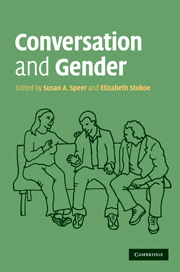Book contents
- Frontmatter
- Contents
- Contributors
- Data and transcription
- 1 An introduction to conversation and gender
- Part I Gender, person reference and self-categorization
- 2 The gendered ‘I’
- 3 Categories in talk-in-interaction: Gendering speaker and recipient
- 4 Doing gender categorization: Non-recognitional person reference and the omnirelevance of gender
- Part II Gender, repair and recipient design
- Part III Gender and action formation
- Part IV Gender identities and membership categorization practices
- References
- Author index
- Subject index
2 - The gendered ‘I’
Published online by Cambridge University Press: 05 June 2012
- Frontmatter
- Contents
- Contributors
- Data and transcription
- 1 An introduction to conversation and gender
- Part I Gender, person reference and self-categorization
- 2 The gendered ‘I’
- 3 Categories in talk-in-interaction: Gendering speaker and recipient
- 4 Doing gender categorization: Non-recognitional person reference and the omnirelevance of gender
- Part II Gender, repair and recipient design
- Part III Gender and action formation
- Part IV Gender identities and membership categorization practices
- References
- Author index
- Subject index
Summary
Introduction
In English, the word ‘I’ does not contain any categorical information about the speaker; neither gender, age, class nor race. It is what Schegloff (1996c: 440) calls ‘reference simpliciter’; it does simple self-reference and its use ‘masks the relevance of the referent and the reference for the talk’ (Schegloff, 1996c: 446) because it is ‘opaque with respect to all the usual key categorical dimensions – age, gender, status and the like’ (Schegloff, 2007c: 123). Building on Schegloff's cogent analysis, the key claim I wish to make in this chapter is that there are instances where a speaker's self-referential ‘I’ can be rendered hearably gendered in the context of its production. In other words, my data show instances in which the ordinary, unremarkable form of self-reference is itself hearably gendered, without the speaker's categorical membership being explicitly linguistically produced. I call this use of ‘I’ the gendered-I. Drawing on extracts from the CTS corpus, I show how the self-reference ‘I’ can be gendered.
I locate my work in the emerging discipline of feminist conversation analysis (see Kitzinger, 2000a; 2007a; Speer, 2002a; 2005a; Stokoe & Weatherall, 2002a) in which gendered identities (and others) are seen as emergent, locally occasioned and routinely constituted in interaction. Feminist conversation analysis resonates with ethnomethodological feminisms (Kitzinger, 2000a: 166), in which men/boys and women/girls are not regarded as always-and-forever talking as gendered beings, but rather may produce themselves or be produced as gendered in the taken-for-granted, routinized details of interaction (see Garfinkel, 1967; Kessler & McKenna, 1978: 136; West & Zimmerman, 1987: 13–14).
- Type
- Chapter
- Information
- Conversation and Gender , pp. 31 - 47Publisher: Cambridge University PressPrint publication year: 2011
- 11
- Cited by



